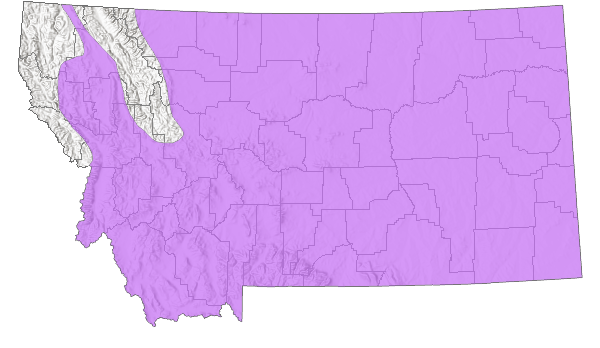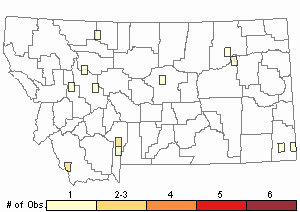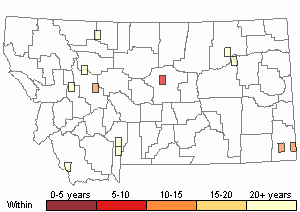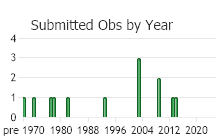View in other NatureServe Network Field Guides
NatureServe
Montana
Utah
Wyoming
Idaho
Wisconsin
British Columbia
South Carolina
Yukon
California
New York
California Amaranth - Amaranthus californicus
Native Species
Global Rank:
G4
State Rank:
S3S4
(see State Rank Reason below)
C-value:
6
Agency Status
USFWS:
USFS:
BLM:
External Links
State Rank Reason (see State Rank above)
Amaranthus californicus is widely scattered throughout Montana. It is associated with wet areas that are often disturbed from manmade and natural sources. It is thought to be native in Montana and undercollected. More information on its locations and population sizes are needed.
- Details on Status Ranking and Review
Range Extent
ScoreF - 20,000-200,000 sq km (~8,000-80,000 sq mi)
Area of Occupancy
ScoreD - 6-25 4-km2 grid cells
Number of Populations
ScoreB - 6 - 20
Number of Occurrences or Percent Area with Good Viability / Ecological Integrity
ScoreC - Few (4-12) occurrences with excellent or good viability or ecological integrity
Environmental Specificity
ScoreB - Narrow. Specialist or community with key requirements common
Threats
CommentThreat category includes: Lack of disturbance. It requires some habitat disturbance (natural or man-made).
Intrinsic Vulnerability
ScoreC - Not intrinsically vulnerable
General Description
Plants: Annual, with separate male and female flowers on the same plant (monoecious). Stems 5-40 cm long and branched at the base, forming a prostrate mat. Foliage glabrous (not hairy) and green to reddish (Lesica et al. 2012). Leaves and stems often fleshy-swollen (Costea and Tardif 2003).
Leaves: Blades obovate to spatulate with wavy margins, 5–15 mm long, longer than the petiole (Lesica et al. 2012). Pale green with obvious veins and a notable short, sharp tip (mucro) (eFloras 2017). Stem leaves wither early, while axillary leaves are long-lived and much smaller (Henrickson 1993).
Inflorescence: Axillary glomerules (sessile clusters) with linear, spine-tipped bracts that are 1–1.5 mm long (Lesica et al. 2012).
(Contribution of Lesica et al. adapted from
Lesica et al. 2012. Manual of Montana Vascular Plants. BRIT Press. Fort Worth, TX)
Phenology
Flowers July to October (Hitchcock et al. 1964).
Diagnostic Characteristics
All other
Amaranthus in Montana except Prostrate Amaranth (
A. blitoides) generally have an upright growth habit; most also have terminal inflorescences. Compared to
A. blitoides, A. californicus has shorter sepals (1 mm or less)(Lesica et al. 2012). Also, California Amaranth has smaller seeds (less than 1.1 mm diameter), compared to Prostrate Amaranth’s 1.3-1.7 mm seeds (Hitchcock et al. 1964; Henrickson 1993).
Amaranthus albus can be confusingly similar to
A. californicus, and herbarium specimens of the two have sometimes been misidentified.
A. albus tends to be more upright, usually with a single rigid, pubescent stem and branches at wide angles, and it lacks fleshy leaves. Female flowers of
A. californicus have one obvious tepal (sepal) with two others reduced or missing, with
A. albus has 3 obvious tepals.
A. californicus fruits tend to be mostly smooth-skinned and narrow abruptly to a long beak, while in
A. albus they are wrinkled and narrow gradually to a shorter beak.
A. californicus seeds are egg-shaped, and
A. albus seeds are round or nearly so. The spiny bracteoles in the inflorescence are equal to the fruits in
A. californicus, and longer in
A. albus (1.5-2X the length of the fruit). However, several of these characters (tepals, fruits, seeds, and bracteoles) are known to overlap at times (Costea and Tardif 2003). See Costea and Tardif 2003 for comparative photos of fruits and seeds.
(Contribution of Lesica et al. adapted from
Lesica et al. 2012. Manual of Montana Vascular Plants. BRIT Press. Fort Worth, TX)
Species Range
Montana Range
Range Descriptions

 Native
Native
Range Comments
MT in Beaverhead, Gallatin, Lewis and Clark, Toole, Powell and Valley counties; AB, SK south to CA, UT, TX (Lesica et al. 2012. Manual of Montana Vascular Plants. BRIT Press. Fort Worth, TX).
Observations in Montana Natural Heritage Program Database
Number of Observations: 18
(Click on the following maps and charts to see full sized version)
Map Help and Descriptions
Relative Density

Recency



 (Observations spanning multiple months or years are excluded from time charts)
(Observations spanning multiple months or years are excluded from time charts)
Habitat
Ecology
In a study near a farm in central Saskatchewan, in which soil samples were collected from four different habitats and studied under laboratory conditions, Amaranthus californicus seeds sprouted from samples taken from agricultural sites in summer fallow and wheat stubble, but not from native prairie or grazed pasture (Archibold 1981). In summer fallow samples, the great majority of reproduction was annual or biennial forbs (96% of individuals per square meter). Of these forbs, a weedy mustard, Thlaspi arvense, made up more than half of the reproduction, and A. californicus made up roughly 2% of the total plants. This site had been in a wheat-fallow rotation. In the wheat stubble samples, the total sprouts of all species were less than a third of those in the summer fallow samples, but A. californicus made up roughly 6% of the total. Most reproduction was short-lived annual forbs (66%), with perennial forbs and annual grasses comprising the rest. Alfalfa (Medicago sativa) had grown on this site for a decade or more until the year prior to the study, which probably reduced the seed bank. The native prairie and grazed pasture, which lacked any germinating A. californicus, differed from each other in many respects, but both had lower numbers of short-lived forbs, higher numbers of perennial forbs, and substantial numbers of perennial grasses and sedges that sprouted vegetatively (45% on native prairie, 67% on grazed pasture).
Pollen from herbarium specimens of A. californicus and A. albus were indistinguishable in form, suggesting a close evolutionary relationship (Costea and Tardif 2003). Likely, A. californicus evolved from A. albus by an affinity for specific habitats such as dried-up lakebeds, though it now occurs in more disturbed habitats as is also typical for White Amaranth (Costea and Tardif 2003).
Reproductive Characteristics
Flowers: Male flowers have 3 acute sepals that are similar in length to the bracts (Hitchcock et al. 1964). Female flowers have 1-3 unequal, acuminate sepals with the longest ca 1 mm long and like the bracts, and the other two small and scale-like or absent (Hitchcock et al. 1964; Lesica et al. 2012). There are no petals and 3 stamens, and the ovary is superior (Lesica et al. 2012).
Fruit: 1 mm, opening by a transverse line (circumscissile) (Henrickson 1993). A 2-3 mm long, green-lined utricle, longer than the sepals (Lesica et al. 2012). Seeds are hard, red-brown, and up to 1.1 mm across (Henrickson 1993).
(Contribution of Lesica et al. adapted from
Lesica et al. 2012. Manual of Montana Vascular Plants. BRIT Press. Fort Worth, TX)
Management
All Amaranthus sp. have edible foliage and seeds (Thayer 2010).
Stewardship Responsibility
References
- Literature Cited AboveLegend:
 View Online Publication
View Online Publication Archibold, O.W. 1981. Buried viable propagules in native prairie and adjacent agricultural sites in central Saskatchewan. Can.J. Bot. 59: 701-706.
Archibold, O.W. 1981. Buried viable propagules in native prairie and adjacent agricultural sites in central Saskatchewan. Can.J. Bot. 59: 701-706. Costea, M. and F. J. Tardif. 2003. Conspectus and Notes on the Genus Amaranthus in Canada. Rhodora 923: 260-281.
Costea, M. and F. J. Tardif. 2003. Conspectus and Notes on the Genus Amaranthus in Canada. Rhodora 923: 260-281. eFloras. 2017. Flora of North America. Missouri Botanical Garden, St. Louis, MO & Harvard University Herbaria, Cambridge, MA.
eFloras. 2017. Flora of North America. Missouri Botanical Garden, St. Louis, MO & Harvard University Herbaria, Cambridge, MA. Flora of North America Editorial Committee, eds. 2003. Flora of North America North of Mexico. Volume 4. Magnoliophyta: Caryophyllidae, Part 1. Oxford University Press, Inc., NY. xxiv + 559 pp.
Flora of North America Editorial Committee, eds. 2003. Flora of North America North of Mexico. Volume 4. Magnoliophyta: Caryophyllidae, Part 1. Oxford University Press, Inc., NY. xxiv + 559 pp. Henrickson, J. 1993. Amaranthaceae: Amaranth Family. pp. 131-134 IN: Hickman, J. (ed.) The Jepson Manual: Higher Plants of California. London, England: University of California Press. 1400 p.
Henrickson, J. 1993. Amaranthaceae: Amaranth Family. pp. 131-134 IN: Hickman, J. (ed.) The Jepson Manual: Higher Plants of California. London, England: University of California Press. 1400 p. Hitchcock, C. L., A. Cronquist, M. Ownbey, and J. W. Thompson. 1964. Vascular Plants of the Pacific Northwest. Part 2: Salicaceae to Saxifragaceae. University of Washington Press, Seattle. 597 pp.
Hitchcock, C. L., A. Cronquist, M. Ownbey, and J. W. Thompson. 1964. Vascular Plants of the Pacific Northwest. Part 2: Salicaceae to Saxifragaceae. University of Washington Press, Seattle. 597 pp. Lesica, P., M.T. Lavin, and P.F. Stickney. 2012. Manual of Montana Vascular Plants. Fort Worth, TX: BRIT Press. viii + 771 p.
Lesica, P., M.T. Lavin, and P.F. Stickney. 2012. Manual of Montana Vascular Plants. Fort Worth, TX: BRIT Press. viii + 771 p. Thayer, S. 2010. Nature's Garden: A Guide to Identifying, Harvesting, and Preparing Edible Wild Plants. Birchwood, WI: Forager's Harvest Press. 512 p.
Thayer, S. 2010. Nature's Garden: A Guide to Identifying, Harvesting, and Preparing Edible Wild Plants. Birchwood, WI: Forager's Harvest Press. 512 p.
- Additional ReferencesLegend:
 View Online Publication
View Online Publication
Do you know of a citation we're missing? Lesica, P., M.T. Lavin, and P.F. Stickney. 2022. Manual of Montana Vascular Plants, Second Edition. Fort Worth, TX: BRIT Press. viii + 779 p.
Lesica, P., M.T. Lavin, and P.F. Stickney. 2022. Manual of Montana Vascular Plants, Second Edition. Fort Worth, TX: BRIT Press. viii + 779 p. Sirirugsa, P. 1973. Descriptive analysis of Montana species of Amaranthus. M.Sc. Thesis. Bozeman, MT: Montana State University. 56 p.
Sirirugsa, P. 1973. Descriptive analysis of Montana species of Amaranthus. M.Sc. Thesis. Bozeman, MT: Montana State University. 56 p.
- Web Search Engines for Articles on "California Amaranth"





